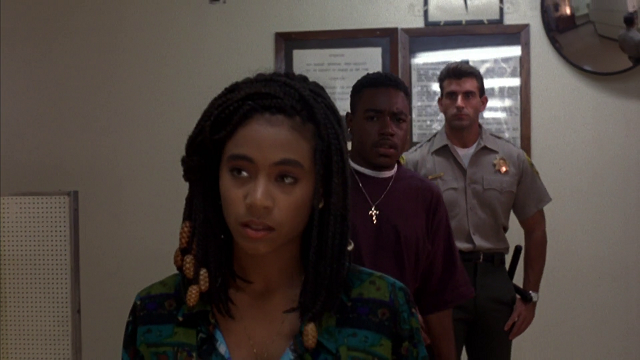John Singleton’s 1991 drama Boyz N The Hood was the first of a type of hood movie where the goal was getting out alive. Focusing on a central intelligent boy growing up in a broken home, Singleton used the film as a dissection of American culture and of the hood life itself. Through Lawrence Fishburne’s father figure, Furious, Singleton held court on a number of issues: from the allure of crime and the life, but also the racist aspects of the socio-economic structures within and without of the hood. Nonetheless, Boyz N The Hood was a striking emotional affair that used hope to try to propel the community forward.
There is far less hope in 1993’s Menace II Society, a bleak response to Boyz N The Hood. The Hughes Brothers were just 19 when they pitched Menace under its first title Rampage. Being young and angry, they created a film where the only way out is to move to another city. This is a world where a white man looking to conduct an insurance scam will come to the slums and hire desperate black men to steal cars for him. Helpful intelligent fathers like Furious are far more scarce, being replaced by Samuel L Jackson’s drug dealing father. Black men are either murdered or jailed, leaving the women to hold it down as much as they can.
In Menace II Society, all of society is against the black community. The film opens with two young black men trying to buy malt liquor from the corner convenience store, and getting the side eye from the shop owners. Cops would beat up kids and then dump them in rival gang territory (a practice that hasn’t stopped; here’s an example from 2011). There are few legit opportunities, and they’re only open for short periods of time. Boyz provided a path forward for the whole community. Menace says that everything’s fucked and the only way to survive is to leave it all behind.
Even by 1993, the formula was already showing signs of repetition. Time Out was already calling Menace a compendium of cliches, even though this form of the hood drama was only a couple of years old. At times, there’s something vital to the writing of Menace, while other characters felt like they were cardboard cutouts. However, Jada Pinkett, in her first big screen role, rises above everybody to embody the voice of reason trying to raise her son right and be the Voice of Reason. Her acting is masterful, and she is a force to be reckoned with.
If nothing else, Menace is all about atmosphere and selling its worldview through music video aesthetics. Cinematographer Lisa Rinzler (Pollock) creates a moody and lurid atmosphere that seems ready to engulf the characters at any minute. Fluorescent bulbs, color floods, and neon are all menaces of money and poverty that threaten to corrupt anything in their wake.
Unlike Boyz, Menace II Society is less for the audience seeking to understand than for the audience seeking their reflection in a Hollywood movie. Even with a narrator, it presents no easy roads in, and no easy roads out.
Menace II Society streams on Netflix

